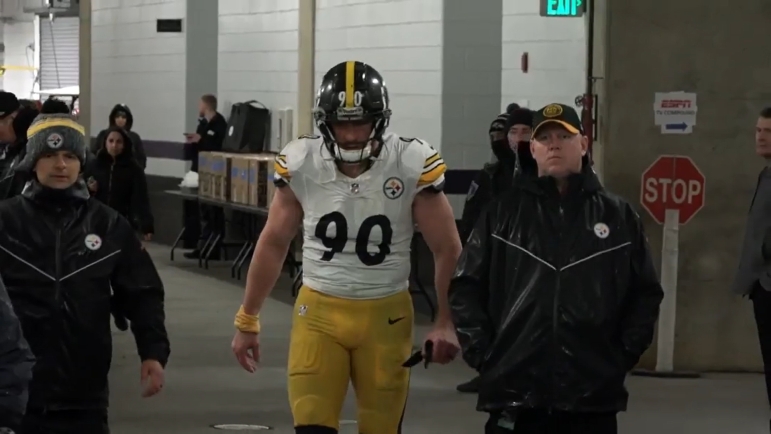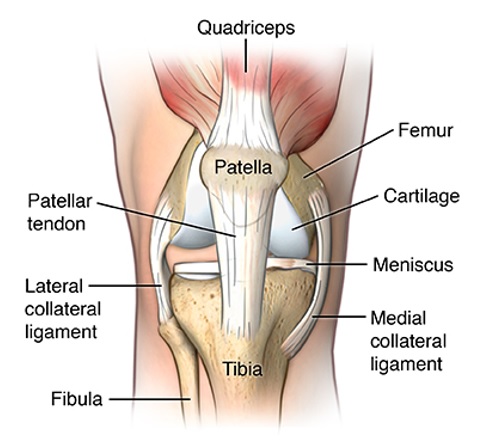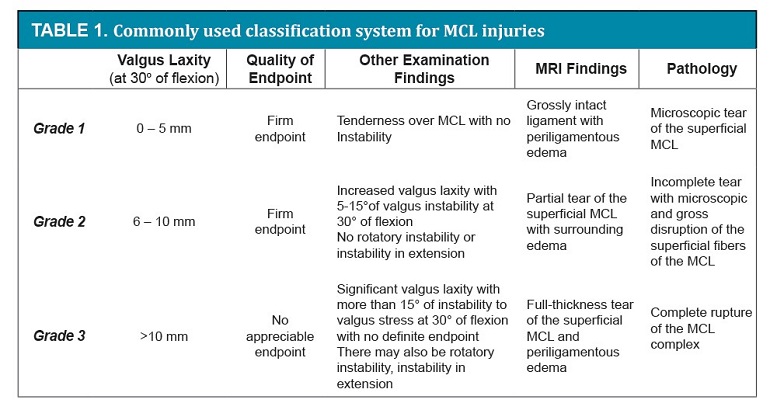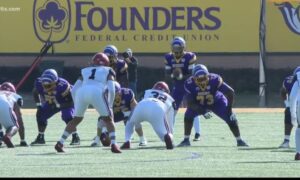Pittsburgh Steelers linebacker T.J. Watt was having a great night in Baltimore in the regular season finale against the Ravens, logging two sacks to take full control the NFL sack lead during the team’s playoff push. Then he went down with a knee injury after getting his left leg bent backwards from contact with teammate Montravius Adams:
Watt was able to walk off the field and then walk to the locker room, where team doctors quickly ruled out his return. NFL Insider Ian Rapoport reported that Watt had suffered an MCL injury and it was suspected to be a Grade 3 tear.
That was good news because it was not believed to be an ACL tear, a much more significant injury. It was also bad news because a Grade 3 tear is typically associated with at least a six week recovery…meaning that even if the Steelers manage to earn a Wild Card playoff berth, they’d be without their star pass rusher, currently in the running for Defensive Player of the Year.
After the game, backup outside linebackers Nick Herbig and Markus Golden stated that Watt likely would not be available next week if the Steelers make the playoffs, as reported by Pittsburgh Post-Gazette’s Ray Fittipaldo. They also acknowledged that they did not have any details on his injury.
So the question that all Steelers fans are asking right now is whether there is any chance that T.J. Watt could be available if the team has a game to play. The answer? Maybe. It all comes down to the extent of the injury.
ANATOMY REVIEW
There are several ligaments that hold the knee joint together. The medical collateral ligament (MCL) runs vertically along the medial side of the knee joint, securing the femur (thigh bone) to the tibia (shin bone), the larger of the two bones between the knee and ankle:
Figure 1 www.hopkinsmedicine.org
The MCL provides stability to the middle side of the knee, particularly when the knee is flexed. A sprain is a stretch and/or tear of a ligament, and it is classified by severity. The MCL consists of superficial and deep ligaments. The superficial MCL is the primary restraint to valgus laxity at the knee. The superficial MCL has one attachment to the femur (thigh bone) and two attachments to the tibia (shin bone). The deep MCL is a thickening of the medial joint capsule and runs deep and parallel to the superficial MCL.
MCL SPRAIN CLASSIFICATION
The severity of an MCL tear can be described in a couple of ways, by the actual ligaments torn or the impact on the knee’s stability.
Here is the breakdown, courtesy of the American Academy of Orthopaedic Surgeons:
Grade 1 sprain (mild): Slight stretching and some damage to the fibers of the ligament.
Grade 2 sprain (moderate): Partial tearing of the ligament. There is abnormal looseness (laxity) in the joint when it is moved in certain ways.
Grade 3 sprain (severe): Complete tear of the ligament. This causes significant instability and makes the joint non-functional.
The other way to measure MCL grade is by the amount of medial joint gapping when a lateral force is applied during physical examination:
Grade 1: Less than 5 mm opening
Grade 2: 5-10 mm opening
Grade 3: Greater than 10 mm opening
Here is a summary of the differences between the three different grade classifications from The Orthopaedic Journal at the Harvard Medical School:
In this schematic, you can see that the difference between a Grade 2 and a Grade 3 injury is also defined by whether both the superficial and deep layers of the MCL are torn:
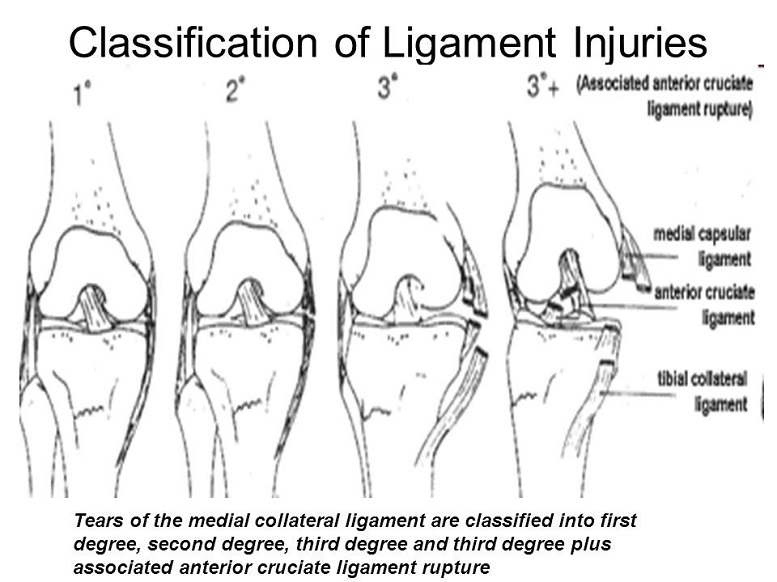
3 Injuries of the Knee (Dr. Sanjeev)
WHAT IS THE TREATMENT?
It always starts with the basic RICE treatment: rest, ice, compression (with a brace), and elevation. Pain can be treated with anti-inflammatory medication like ibuprofen and sometimes narcotics like Vicodin. For some Grade 3 tears, surgery is sometimes recommended, as we saw with former Steelers running back James Conner, who underwent MCL repair in 2017.
WHAT IS THE RECOVERY TIME FOR NFL LINEBACKERS WITH MCL TEARS?
Most MCL tears heal without surgery unless there is an associated meniscal tear or another ligament is also injured. Return to play depends primarily on the severity of the tear but the position played is a factor as well. QBs and linemen can sometimes return faster than RBs, WRs, DBs and LBs, who do more cutting.
Grade 1 injuries are pretty mild and most NFL players will be back on the field in 1-2 weeks. With a Grade 2 injury, it is typically a 3-4 week recovery. Even isolated Grade 3 injuries typically do not require surgical repair because the two torn ends can scar back together. This can take 6-8 weeks.
Looking at a few linebackers who have sustained MCL injuries in recent years shows some variability in the number of games missed:
- Eagles LB Kamu Grugier-Hill suffered a Grade 3 MCL tear in training camp in 2019 and missed eight weeks.
- Buccaneers LB Devin White had a Grade 1 MCL tear during Week 2 in 2019 and didn’t miss a game.
- Cowboys veteran backup LB Sean Lee (who has had three ACL tears and surgery each time), had a Grade 2 MCL during training camp in 2019 and missed 4 weeks but was ready for the season opener.
- Broncos Pro Bowl LB Von Miller also had a Grade 2 MCL tear in 2019, missing one game and breaking his 95-game streak going back to 2013.
- As Steelers fan may recall, star LB Ryan Shazier suffered MCL injuries in his rookie season (2014) and again in 2016. Both were considered Grade 2 tears. In 2014, he missed four weeks. In 2016, he returned after three weeks, which turned out to be too soon. He missed another game the following week and then returned after the bye week.
WHAT IS THE GRADE OF WATT’S MCL TEAR?
No one knows. There is only so much information trainers and doctors have available during the game, especially on the road, where resources may be more limited. An X-ray won’t give a definitive answer on the extent of the ligament tear, even if it shows some widening of the joint at the medial aspect. So until Watt returns to Pittsburgh and has an MRI, it’s all speculation.
It’s safe to assume that TJ Watt has more than just a Grade 1 MCL sprain and would miss at least one game. Beyond that, we have to wait for the MRI results. If the Steelers are eliminated, we may never get any updates. If their season is not over, I would guess that an NFL insider will leak it before the next time Mike Tomlin meets with the media.
It is unlikely that the team would put Watt’s health at risk and clear him to play sooner than it is safe. But when it comes to the playoffs, injuries are handled differently, and players will push to get on the field. If you want a best case scenario, consider Seattle Seahawks safety Kam Chancellor, who played in Super Bowl XLIX with a torn MCL and a bone bruise sustained only two days prior to the game. So if the Steelers can find their way to the postseason and make it past the first round, I would not rule Watt out just yet.
Melanie H. Friedlander, M.D., F.A.C.S. is a board-certified general surgeon at the Association of South Bay Surgeons in Torrance, California. She has developed and published many scientific studies in highly esteemed medical journals

